Rediscovery of Odisha
Rediscovering the old state of Odisha, where splendid monuments and sculptures, golden beaches, swift rivers, azure lakes, roaring waterfalls, verdant hills and wildlife parks beckon a growing number of visitors
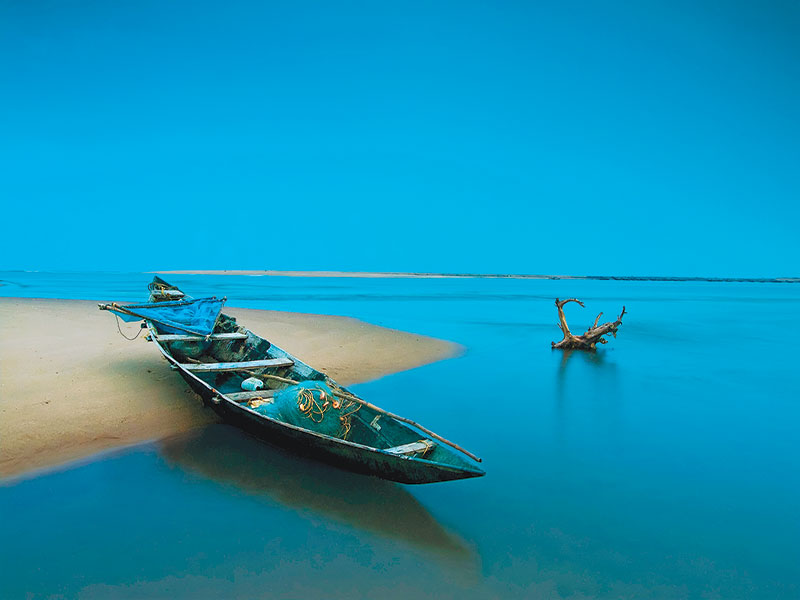
In the popular perception, the eastern seaboard state of Odisha (pop. 40 million) known mainly for the Puri Jagannath and Konark Sun temples and ancient cultural landmarks is a distant place, situated somewhere out there in the great Indian outback. Formerly, the epicentre of the historic Kalinga kingdom of Emperor Ashoka, Odisha with its 4,000 stunningly-crafted monuments, famed archaeological sites, early Jain cave temples, Buddhist monasteries, Hindu temples, mosques, forts, palaces and splendid colonial architecture, is re-impacting itself upon the national consciousness as a tourism destination.
Little is known about the state’s early history except that the region was originally inhabited by Buiya and Gond tribals. Circa 400 BCE the region was united under the Kalinga dynasty which established a fiercely independent kingdom. In 260 BCE Emperor Ashoka (232-273 BCE) of the neighboring Mauryan empire based in Pataliputra invaded and subdued Kalinga after a long and bloody war of conquest.
The conquest of Kalinga was a turning point for Ashoka, who, anguished by the horror and destruction of the war, converted to Buddhism and established one of the most peaceful and prosperous kingdoms in Indian history. Later in the second century, the Kharavela dynasty established strong rule over the region and built numerous temples.
From 400-1000 AD the region was administered by the Gupta, Bhaumakara and the Soma dynasties followed by the Gangas (1100-1200). During the late 13th century, the Delhi sultanate established suzerainty over the region and continued to rule until 16th century, when it was conquered by the Mughals. Following the death of Emperor Aurangzeb in 1707, the Nawab of Bengal took over and ruled the state till its cessation to the British East India Company in 1803. It was only in 1949, two years after India attained independence, that Orissa state was constituted. The name was changed from Orissa to Odisha, and its language from Oriya to Odia, in 2011, after the Alteration of Name and 113th Amendment Bills, were passed in the Parliament in 2010.
In the new era of incremental domestic and international tourism, Odisha’s kaleidoscopic culture, splendid architecture, monuments and sculptural art, as also its golden beaches, swift rivers, azure lakes, roaring waterfalls, verdant hills and wildlife parks have begun to attract a growing number of visitors.
Bhubaneswar
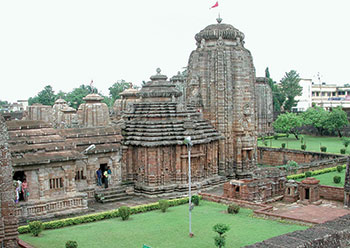 The state’s capital, Bhubaneswar — its landscape studded with over a hundred ancient temples — is the gateway to the cultural wealth of Odisha. The city (pop. 929,000) derives its name from the Sanskrit word Tribhuvaneswara, synonymous with Lord Shiva.
The state’s capital, Bhubaneswar — its landscape studded with over a hundred ancient temples — is the gateway to the cultural wealth of Odisha. The city (pop. 929,000) derives its name from the Sanskrit word Tribhuvaneswara, synonymous with Lord Shiva.
Against this multi-hued tapestry of history and the soaring sandstone spires of old Bhubaneswar, a new capital has taken shape. The modern architectural designs of present-day Bhubaneswar contrast in sharp relief with the old city. Nevertheless, mindful of its unique status, Bhubaneswar is a calm, progressive city, comfortably linking the old and new.
Renowned for its ancient temples — Lingaraja, Rajarani, Gundicha, Lokanath and Tota Gopinath — Bhubaneswar is veritably the ‘Temple City of India’. History records that more than 2,000 temples existed here, many of which were destroyed by the Mughals. The Lingaraj temple dedicated to Lord Shiva, with a 184 ft tall spire, dominates the city’s horizon. Set in a walled enclosure, the main temple is surrounded by numerous smaller shrines. Notable among them is the one dedicated to Parvati, Lord Shiva’s consort. Open only to Hindus, the Lingaraj temple hosts a major annual Shivaratri festival in February-March.
Culture tourists must also visit the Parasuramesvera temple built in 650 AD, and one of the finest examples of temple architecture. The best preserved of all ancient temples in the city, it displays finely detailed bas-reliefs of elephant and horse processions and images of Lord Shiva. Yet perhaps the highlight of the temple treasures is the 11th century Rajarani aka Love temple, embellished with erotic sculptures and graceful feminine images.
Temples and monuments apart, contemporary Bhubaneswar with its glass-facade buildings, glitzy shopping malls, and well developed tourism infrastructure is a good starting point to explore other parts of the state. While in Bhubaneswar don’t miss the fresh water tanks of Sweta Ganga and Indradyumna in the heart of the city. Moreover Forest Park, Buddha Jayanti Park and the Kalinga Stadium are popular attractions.
Accommodation. Top-end: Hotel Sishmo (Rs.5,652-12,282), The Royal Midtown (Rs.2,720-4,254), Hotel Pushpak (Rs.2,306-3,983), Hotel Keshari (Rs.1,046-2,232). Budget: Hotel Bhagwat Nivas (Rs.250-450), Hotel Deepali International (Rs.275-350), Hotel Padma (Rs.200-250).
Excursions
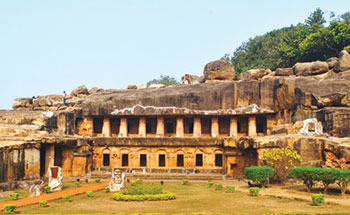 Bhubaneswar offers several historical and scenic attractions within easy reach. The Khandagiri and Udayagiri Caves (7 km) contain chiseled sculptures by Jain monks of the 1st century BC. Dhauli (8 km) surrounded by emerald paddy fields was the battleground of the bloody Kalinga war which led to Emperor Ashoka’s transformation into a compassionate champion of Buddhism. Along Dhaulia’s foothills, one can spot the rock edicts of Ashoka and a skillfully sculpted elephant hewn out of a huge rock. This quaint town has also gained prominence as a Buddhist centre of learning after the installation of a Buddhist Peace Pagoda aka Shanti Stupa in the early 1970s.
Bhubaneswar offers several historical and scenic attractions within easy reach. The Khandagiri and Udayagiri Caves (7 km) contain chiseled sculptures by Jain monks of the 1st century BC. Dhauli (8 km) surrounded by emerald paddy fields was the battleground of the bloody Kalinga war which led to Emperor Ashoka’s transformation into a compassionate champion of Buddhism. Along Dhaulia’s foothills, one can spot the rock edicts of Ashoka and a skillfully sculpted elephant hewn out of a huge rock. This quaint town has also gained prominence as a Buddhist centre of learning after the installation of a Buddhist Peace Pagoda aka Shanti Stupa in the early 1970s.
The ancient ruins of Sisupalgarh, a mere 2 km from Bhubaneswar date back to the third century BC and are testimony to the town planning knowhow of the original inhabitants of the region. Hirapur (15 km) hosts the famed 11th century hypaethral (roofless) temple of 64 Yoginis, the second of its kind in Odisha and one of four such temples in the subcontinent. Contiguous to Hirapur is Atri (42 km), ensconced amidst swathes of green, and known for its hot sulphur springs.
Sited in the heart of the Chandaka forest, the Nandankanan Biological Park (25 km), is a nationally famous zoo which houses animals in their natural habitats. Tigers, lions, clouded leopards, black panthers, European brown bear, Himalayan black bear, gharials, rosy pelican, grey pelican, Indian python and king cobra all live in happy co-existence at this famous zoo. The zoo’s Botanical Garden nurtures rare and exotic flora.
Cuttack
One of Odisha’s oldest cities, Cuttack (pop. 606,000), earlier known as the Abhinaba Baranasi Katak, is situated at the apex of a delta formed by the rivers Mahanadi in the north and Kathajodi in the south. A former capital of the state, it is now a district headquarter town. Owing to its fertile land and strategic location for trade and commerce, Cuttack continues to loom large in the state’s economy.
Contemporary Cuttack — a mere hour’s drive from Bhubaneswar — is a bustling commercial town. Of particular interest is the Stone Revetment along the riverbanks of the city. It is testimony to the remarkable technological skills of 11th century India.
Among Cuttack’s other attractions are the 14th century Barabati Fort on the banks of the Mahanadi, and the Quadam-i-Rasool, a sacred shrine for Hindus and Muslims, believed to contain the footprint of Prophet Mohammed. The shrine comprises three mosques crowned by striking domes and a nawabat khana (music gallery). Also on most tourist itineraries is the Chandi temple, a revered Hindu shrine.
Konark
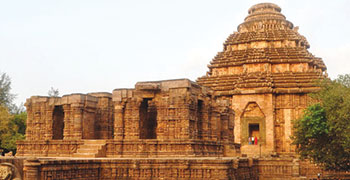 The awesome Sun Temple at Konark (65 km from Bhubaneswar) displays the distinctive style of temple architecture in all its glory. Constructed in the mid-13th century by Odia king Narasimhadev I to celebrate a famous victory over Muslim invaders, it suffered its first attack when Mughal invaders removed the copper over its cupola leading to the partial collapse of its 40 m tall shikara. Notwithstanding this and the ravages of time, its beauty and magnificence rendered Nobel Laureate Rabindranath Tagore speechless. Said Tagore: “….at Konark, the language of stone surpasses the language of man”. The massive temple — now in ruins — stands in solitary splendour surrounded by drifting sands.
The awesome Sun Temple at Konark (65 km from Bhubaneswar) displays the distinctive style of temple architecture in all its glory. Constructed in the mid-13th century by Odia king Narasimhadev I to celebrate a famous victory over Muslim invaders, it suffered its first attack when Mughal invaders removed the copper over its cupola leading to the partial collapse of its 40 m tall shikara. Notwithstanding this and the ravages of time, its beauty and magnificence rendered Nobel Laureate Rabindranath Tagore speechless. Said Tagore: “….at Konark, the language of stone surpasses the language of man”. The massive temple — now in ruins — stands in solitary splendour surrounded by drifting sands.
Sculpted in the shape of a colossal chariot yoked to seven horses carrying the Sun God (Surya) across the heavens, the construction of the temple’s huge edifice took 12 years of sustained effort. The main tower, which has now collapsed, followed the style of the Lingaraja and Jagannath temples in Bhubaneswar and Puri, but only taller. The Jagmohana (porch) itself exceeded 120 ft in height. Both the tower and the porch are built on high platforms, around which are placed the 24 giant stone wheels of the celestial chariot.
Accommodation. Konark doesn’t offer much choice in terms of residential accommodation. There are several hotels and lodges with rudimentary facilities. The Odisha Tourism Development Corporation Panthinivas hotel offers ordinary and deluxe rooms in the range of Rs.1,541-2,451. Other options include Yatri Nivas (Rs.1,607-3,215), Labanya Lodge (Rs.1,674 onwards).
Puri
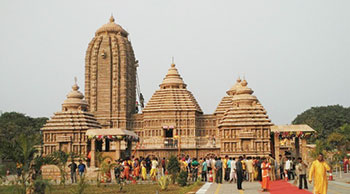 A mere 60 km from Bhubaneswar, Puri (pop. 200,000) is the point of culmination for the devout Hindu and his fellow traveller. That’s because the town is home to the celebrated Jagannath (Lord of the Universe) temple. As a consequence this tiny seaside town is perhaps the best known habitation of Odisha.
A mere 60 km from Bhubaneswar, Puri (pop. 200,000) is the point of culmination for the devout Hindu and his fellow traveller. That’s because the town is home to the celebrated Jagannath (Lord of the Universe) temple. As a consequence this tiny seaside town is perhaps the best known habitation of Odisha.
Inevitably Puri’s main attraction is the spectacular 192 ft Jagannath temple. It represents the acme of Odia architecture, and the lofty jet black deity is the cynosure of every eye. The temple houses Lord Jagannath, his brother Balbhadra and sister Subhadra who are continually garlanded and dressed for various ceremonies through the day by the temple’s 6,000 male employees. Every year in June/ July, Puri is the venue of one of India’s most celebrated festivals — the Rath Yatra during which the deities are hauled in three differing raths (chariots) from the Jagannath temple to the neighbouring Gundichu temple, symbolically commemorating Lord Krishna’s journey from Gokul to Mathura.
Puri’s clean beaches afford vistas of crimson sunsets and golden sunrises across the azure expanse of the Bay of Bengal.
Accommodation. Top-end and mid-range: Mayfair Beach Resorts (Rs.6,569-21,873), Victoria Club Hotel (Rs.850-3,250), Puri Hotel (Rs.500-1,500), Marine Resorts (Rs.800-1,500). Budget: Hotel Love and Life (Rs.2,735-4,208), Hotel Derby (Rs.5,000 onwards).
Chilika
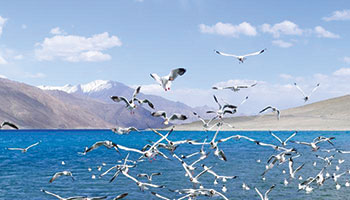 The largest brackish water lagoon in India — with an estuarine character — Chilika lake swells from 600 sq km in summer to 1,100 sq km, along the state’s eastern coast during the monsoon. With its unique flora and fauna, Chilika supports the livelihoods of more than 100,000 families living in and around it.
The largest brackish water lagoon in India — with an estuarine character — Chilika lake swells from 600 sq km in summer to 1,100 sq km, along the state’s eastern coast during the monsoon. With its unique flora and fauna, Chilika supports the livelihoods of more than 100,000 families living in and around it.
Because of its rich bio-diversity and socio-economic importance, Chilika is a magnet for eco-tourists. The lake is visited by a million migratory birds that flock here every winter from as far as the Caspian Sea, Aral Sea, Mongolia and Ladakh, making it an ornithologist’s delight. Another attraction is the Irrawady dolphins which migrate here each winter, to escape the icy waters of the Atlantic.
Accommodation. There are few accommodation options by the lakeside. Among them: OTDC’s Panthanivas at Rambha (Rs.1,395-2,999), Yatri Nivas (Rs.300 onwards).
Rambha/ Rushikulya
The small town of Rambha is the nearest place to stay for turtle watching on Rushikulya beach. Naturalists, ecologists and tourists flock to this site between late October and early December, when the endangered Olive Ridley turtles mass at sea. In January they congregate near nesting beaches and come ashore over four-five days to lay their eggs in the soft wet sand. The eggs hatch 50-55 days later and hatchlings are guided to sea by the luminescence of the ocean. With a national highway with bright lorry lights running within 2 km of the beach, the baby turtles often paddle the wrong way. However members of the Sea Turtle Protection Committee keep vigil and guide them to the sea.
Similipal
Thick evergreen forest, extensive grasslands and meadows, mist-swathed mountains, precipitous waterfalls, flying squirrels and roaring tigers combine to constitute the breathtaking Similipal Biosphere Reserve (SBR).
Sprawled over 2,750 sq km, SBR is one of India’s most protected national parks. The wide range of rainfall and topographical variations — dry deciduous to moist green forests — make SBR an ideal habitat for myriad flora and fauna. Over 1,076 species of plants including 87 orchids, 42 species of mammals, 29 types of reptiles and 231 bird species inhabit this bio reserve.
Accommodation. The only accommodation options are the forest bungalows of Odisha Forest Department (Rs.500 onwards) and OTDC’s Aranya Nivas Tourist Lodge (Rs.1,000 onwards).
Bhitarkanika
Bound by rivers on three sides and the sea on the fourth, the Bhitarkanika Sanctuary and national park is crisscrossed by numerous creeks and canals which finally meet the sea, making the estuarine delta the natural playground of the Bay of Bengal. Widely acclaimed for its biodiversity, Bhitarkanika contains the second largest mangrove ecosystem after the Sundarbans (West Bengal) in India. It’s accessible only by boat via waterways through Chandibali, Gupli and Rajnagar.
Accommodation. Aranya Nivas (Rs.50-150) and Forest Rest Houses (Rs.150-300) are the only options.
Chandipur
The seaside village of Chandipur, 230 km from Bhubaneswar, hosts perhaps one of the world’s most natural beaches set amid casuarina jungles and creepered sand dunes. This spectacular beach is one of the few in the world where the sea retreats five km from shore during low tide. A popular excursion is to the mouth of the river Budhabalanga in a fisherman’s boat to view the river-sea confluence.
Accommodation. A range of mid-level and economy hotels offer rudimentary facilities.
Among them: Panthanivas Tourist Bungalow (Rs.1,541-2,451), Shanti Nivas (Rs.450-850) and Hotel Chandipur (Rs.905-1,045).
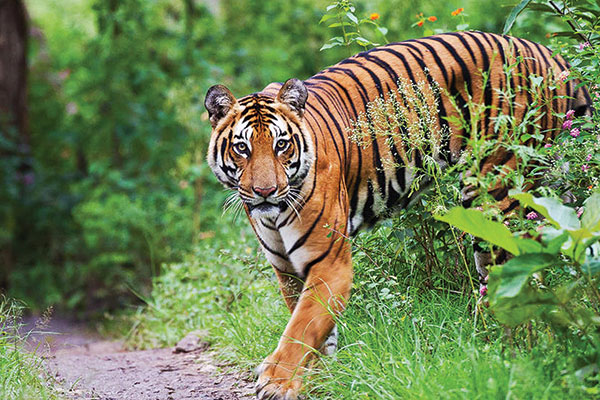 Also Read:
Also Read:
Temple treasures of Tamil Nadu
















Add comment